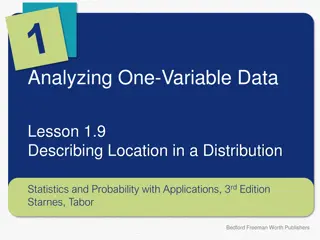Outcomes of Ventral Incisional Hernias <2cm: A Propensity Score-Matched Analysis
This study presents outcomes of ventral incisional hernia repair <2cm using a propensity score-matched analysis. The research evaluates mesh versus primary repair methods and explores complications and recurrence rates. Insights from adult patients undergoing hernia repair from 2012-2021 are include
0 views • 18 slides
Understanding Consumption, Saving, and Investment in Economics
Consumption in macroeconomics refers to total spending on consumer goods and services, while saving is the act of abstaining from consumption. Investment involves creating capital goods and acquiring financial assets. Engle's Law states that the proportion spent on necessities decreases with income.
0 views • 13 slides
Understanding iReady Scores and Their Significance for Your Child
iReady scores play a crucial role in identifying your child's strengths and weaknesses in reading and math. This presentation explains what iReady is, how to access the scores in HAC, and what the numbers mean in terms of scale scores and grade level expectations. By understanding these scores, pare
0 views • 10 slides
Psychological Theories of Criminality: Understanding the Roots
Psychological theories of criminality delve into the association between intelligence, personality, learning, and criminal behavior. Major theories include Psychodynamic Theory by Freud, Behavioral Theory by Bandura, and Cognitive Theory by Kohlberg. These theories explore how unconscious mental pro
1 views • 20 slides
Understanding Credit Reports and Scores: A Comprehensive Overview
Explore the importance of credit reports and scores in financial empowerment through modules on reviewing credit reports, understanding credit scores, and mastering credit basics. Learn how good credit can impact your ability to obtain loans, credit cards, secure rentals, insurance coverage, and emp
3 views • 35 slides
Integration Approaches of Propensity Scores in Epidemiologic Research
Propensity scores play a crucial role in epidemiologic research by helping address confounding variables. They can be integrated into analysis in various ways, such as through regression adjustment, stratification, matching, and inverse probability of treatment weights. Each integration approach has
0 views • 20 slides
Understanding Keynesian Consumption and Savings Functions in Macroeconomics
Keynesian consumption function details the relationship between total consumption and gross national income. It emphasizes the stability of aggregate consumption and the marginal propensity to consume. Similarly, Keynesian savings function illustrates the link between savings and national income, hi
0 views • 6 slides
Understanding FAST Grades 2022-2023: ELA and Mathematics Scores Overview
The Understanding FAST Grades 2022-2023 provides detailed insights into the scoring system for ELA and Mathematics assessments from grades 3 to 10. It outlines the three progress monitoring windows (PMs) - PM1, PM2, and PM3 - and explains how the scores are reported at various levels. The provisiona
0 views • 9 slides
Targeted Learning Framework for Causal Effect Estimation Using Real World Data
Hana Lee, Ph.D., presents a webinar on the Targeted Learning Framework for Causal Effect Estimation using Real World Data (TMLE). The project aims to help the FDA develop a structured approach to incorporating real-world data into regulatory decision-making. TMLE offers a systematic roadmap aligned
0 views • 27 slides
Impact of Savings and Credit Cooperatives on Household Welfare in Uganda
Global poverty reduction is a key focus of Sustainable Development Goals, with financial inclusion playing a significant role. This study focuses on the impact of Savings and Credit Cooperative Organizations on member households in Uganda, evaluating access to services and their influence on househo
0 views • 20 slides
Understanding Probability and Calculating Probabilities with Z-Scores
Probability is a number between zero and one that indicates the likelihood of an event occurring due to chance factors alone. This content covers the concept of probability, the calculation of probabilities using z-scores, and practical examples related to probability in statistics. You will learn a
0 views • 12 slides
Key Stage 2 SATs Changes and Expectations 2018/19 Overview
Changes in Key Stage 2 SATs including the introduction of a new national curriculum framework, abolition of old national curriculum levels, and transition to scaled scores. Parents can expect their child’s test results to be reported in scaled scores, with 100 representing the national standard. T
1 views • 10 slides
Understanding Marginal Propensity to Consume and Save
Marginal Propensity to Consume (MPC) and Marginal Propensity to Save (MPS) measure the ratios of change in consumption and saving to change in disposable income respectively. The relationship between MPC and MPS shows that they equal 1 when combined, with the remainder being saved. The multiplier ef
7 views • 5 slides
Understanding Propensity Score Methods for Reducing Confounding in Studies
This content discusses the use of propensity score methods to address confounding in observational studies, comparing randomized control trials (RCTs) with observational studies, explaining the potential outcome framework, average treatment effects, and common assumptions made in these methods to re
0 views • 12 slides
Understanding Correlational Research in Psychology
Correlational research in psychology focuses on determining the degree of relationship between variables without manipulation. It helps show the magnitude of association but not causation. Correlation coefficient indicates the existence, degree, and direction of the relationship between variables. P
0 views • 38 slides
VCE Greek Studies: Curriculum, Assessment, and Study Scores
VCE Greek Studies cover a range of themes over two years, focusing on areas such as Philosophy, Environment, Migration, and Greek Resistance. Students are assessed through tasks like writing, speaking, and reading comprehension. The study score is a reflection of a student's performance in compariso
0 views • 18 slides
Understanding Keynesian Consumption and Savings Functions in Macroeconomics
Keynesian Consumption Function relates total consumption to national income, with stable characteristics like MPC and APC. Savings Function shows the relationship between savings and income, highlighting the Marginal Propensity to Save and Average Propensity to Save. Both functions are essential con
0 views • 6 slides
Evaluating Bias in Value-Added Models Using Prior Scores
Outcome-based value-added (VA) models are commonly used to assess productivity in various fields. This study explores the use of prior scores to evaluate bias in VA estimates, focusing on the correlation between current teacher VA and lagged outcomes. The analysis highlights the sensitivity of balan
0 views • 38 slides
Comparing Bleeding and Mortality Risks of Dabigatran vs. Rivaroxaban in Elderly Medicare Beneficiaries
A study by DJ Graham et al. compared the risks of stroke, bleeding, and mortality in elderly Medicare beneficiaries with nonvalvular atrial fibrillation treated with dabigatran or rivaroxaban. The study included over 118,000 patients and found that dabigatran was associated with a lower risk of majo
0 views • 9 slides
Understanding Credit-Based Insurance Scores and Their Regulation
Credit-based insurance scores are numeric representations of insurance claim risk based on consumer credit details. Factors considered include credit history, types of accounts, recent activity, utilization, and payment history. Gender, marital status, age, address, occupation, and education are not
0 views • 10 slides
Comprehensive Analysis of Gene Expression and Regulatory Potential Through eCLIP Profiles
Explore a thorough examination of gene expression and regulatory potential using eCLIP profiles, shRNA, RNA-Seq, secondary structure conservation, and prioritized genes. Uncover insights on users' variants, regulator scores, nucleotide scores, RBP rank lists, mutation burden, and more. Dive deep int
3 views • 10 slides
Vacation Expenses Analysis and Z-scores Computation
Explore the concept of measuring dispersion using standard deviation units and calculating z-scores for a dataset related to vacation expenses. Learn how to interpret z-scores, analyze normal distributions, and apply statistical concepts to real-world scenarios involving amusement park trip heights.
0 views • 18 slides
Massachusetts Educational Policy Study: Long-Term Outcomes & MCAS Scores
This study from Brown University explores how high school MCAS scores in Massachusetts predict long-term success and academic skills, impacting students' college and career readiness. Findings indicate students near passing cutoffs struggle, but additional attempts can improve outcomes. MCAS scores
0 views • 37 slides
Exploring Entrepreneurial Activities in Extra-curricular Enterprise Programs at Plymouth University
Investigate the impact of extra-curricular enterprise activities on entrepreneurial capabilities, behaviors, and competencies, featuring insights from Dr. Emily Beaumont, Sarah Preedy, and Sarah Stevenson. The study delves into the development workshops and events like Social BETA Enterprise, FLUX T
0 views • 20 slides
Understanding Regression Lines for Predicting English Scores
Learn how to utilize regression lines to predict English scores based on math scores, recognize the dangers of extrapolation, calculate and interpret residuals, and understand the significance of slope and y-intercept in regression analysis. Explore the process of making predictions using regression
0 views • 34 slides
Estimation of Causal Effects using Propensity Score Weighting
Understanding causal effects through methods like propensity score weighting is crucial in institutional research. This approach helps in estimating the impact of various interventions, such as a writing program, by distinguishing causation from correlation. The use of propensity score matching aids
0 views • 22 slides
Preliminary Outcomes of Massachusetts Early College Program
Massachusetts Early College Program, launched in 2018, shows promising outcomes based on data analysis for the 2019 cohort. The program focuses on students of color and aims to bridge high school and college experiences. Data sources include SIMS, SCS, MCAS, NSC, and FAFSA. Methodology involves prop
0 views • 13 slides
Impact of Chronotype on Developing Eating Disorders
Chronotypes, representing individuals' morningness-eveningness preference, play a significant role in the propensity to develop eating disorders. Evening chronotypes, facing a mismatch between their internal clock and societal demands, have been linked to various health and mental health issues. A s
0 views • 5 slides
Understanding Location in a Distribution of Data
In this lesson on describing location in a distribution, you will learn how to find and interpret percentiles in quantitative data distributions, estimate values using cumulative relative frequency graphs, and understand standardized scores (z-scores). The concept is illustrated through examples lik
0 views • 16 slides
Understanding Item-Response Theory (IRT) in Educational Assessments
This lecture covers the design and use of test scores, focusing on the principles of Item-Response Theory (IRT) in large-scale international assessments. IRT aims to measure latent traits reliably by analyzing individual question responses rather than just total scores. The advantages of IRT over Cl
0 views • 53 slides
Understanding Z-Scores in Data Analysis
Z-Scores are standardized measurements that indicate how far a data value is from the mean in a dataset. By calculating Z-scores, analysts can compare different data points and understand their relative positions within the distribution. This summary covers the concept of Z-scores, how to calculate
0 views • 19 slides
Understanding Cognitive Abilities Test (CogAT) for Educational Planning
The Cognitive Abilities Test (CogAT) is a benchmark test administered to third-grade students in the WCPSS for educational planning. The test measures verbal reasoning, math reasoning, and visual-spatial reasoning skills through different subtests and composite scores. These scores help in predictin
0 views • 17 slides
Command-Line Application for Retrieving Course Scores
Implement a command-line application that allows users to retrieve their course scores securely. The application ensures that each student can access only their own score by authenticating with their username and SSN. Scores are maintained in a file and can only be read by the root user. The program
0 views • 27 slides
Analyzing SAT Mathematics and Critical Reading Scores
This content covers a regression analysis between SAT Mathematics and Critical Reading scores, including calculating the regression line, predicting scores, identifying outliers, interpreting residuals, slopes, and y-intercepts, and assessing the relationship between exercise habits and fast-food co
0 views • 15 slides
Understanding Gender Attitudes in Southern Africa
The Gender Progress Score (GPS) survey collected responses from 15 countries in Southern Africa between 2019 and 2021 to gauge gender attitudes. With a total of 34,323 responses, the survey revealed insights on gender attitudes, with women comprising 49.5% of respondents. The scores ranged across th
0 views • 18 slides
Understanding Dual Credit Education and Eligibility Criteria
Dual credit programs allow high school students to earn college credits while still in high school, providing numerous benefits such as cost savings, weighted GPA benefits, and a smoother transition to college. Eligibility for dual credit courses is typically based on meeting criteria such as TSI sc
0 views • 16 slides
Understanding Scoring Scales: Meaning, Calculation, and Advantages
Scoring scales are used to assign numerical values to observations for quantifying attributes or behaviors in various fields. They provide a systematic way to evaluate or measure variables, convert qualitative data into quantitative data, and facilitate analysis and interpretation. This article disc
0 views • 22 slides
Understanding the Uniform Bar Exam (UBE)
The Uniform Bar Exam (UBE) is a standardized test administered in multiple jurisdictions simultaneously, consisting of Multistate Performance Test (MPT), Multistate Essay Exam (MEE), and Multistate Bar Exam (MBE) components. It offers portability of scores, benefits test-takers with consistent subje
0 views • 12 slides
Analysis of National Alcohol Consumption and Happiness Scores
The study conducted a comparison between national alcohol consumption and happiness scores to determine if countries with higher alcohol consumption are also the happiest. Data from two separate datasets focusing on alcohol consumption and happiness scores of 145 countries were analyzed. The researc
0 views • 10 slides
Sensitivity Analysis of Performance by Practice Areas at Kaplan
Sensitivity analysis of performance in different practice areas at Kaplan reveals high scores in Ethics and Contract Law, and low scores in Business Law & Practice and Dispute Resolution for SQE1. For SQE2, high scores were observed in Legal Research - Dispute Resolution, Advocacy - Criminal Litigat
0 views • 13 slides







































